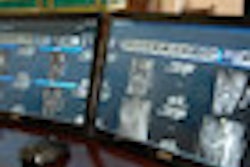NEW YORK CITY - PACS technology may have revolutionized the way radiology departments operate, but it isn't very smart. It's high time that new PACS applications incorporate artificial intelligence, Dr. Eliot Siegel told attendees at the New York Medical Imaging Informatics Symposium.
Siegel, chief of imaging services at the VA Maryland Health Care System in Baltimore, and the radiologist who orchestrated adoption of the first full-hospital PACS in 1993, predicts that PACS technology is on the brink of change. In his opinion, it has to be, because the PACS networks sold today are nearly as "dumb" as they were when first commercialized.
In a September 10 presentation, Siegel discussed how little change has occurred, and what PACS could do with technology that is being used in other industries.
PACS as commodity
PACS is a commodity that hasn't kept up with innovation, according to Siegel, who described the best-run radiology department he'd ever seen -- a film-based department at the Mayo Clinic in Rochester in the early 1990s.
Dedicated, intelligent support staff hung films of prior exams based on knowing the preferences of the radiologist, and sat next to radiologists transcribing and editing reports that contained no inconsistencies, were neither too long nor too short, and were grammatically correct with no spelling errors.
Support staff would suggest a break when seeing that a radiologist was not as alert as he or she should be. Support staff would make sure that critical results were reported to the appropriate physicians, kept track of, and personally follow up on whether recommendations for additional imaging exams were implemented, as well as monitor telephone calls, identifying the ones that merited interrupting a radiologist.
"Today's PACS should be able to replicate these functions," Siegel stated. "It needs to be smarter than a fifth grader."
PACS should incorporate smart technology, such biometric identification systems. He explained that the PACS at his hospital requires a password with all capital letters, a safety feature that has become tedious over the past 19 years he's been using it.
It needs to be intuitive and learn the preferences of the radiologists who use it. His PACS is repeatedly asking "Are you sure?" After years of use, it should know the answer, he joked.
The hanging protocol preferences of radiologists are triggered when they log into the system, but they need to now offer intelligent configurations that are much more sophisticated to better manage the huge volume of images in exams that radiologists must contend with.
Images of current and related prior exams need to be able to be lined up volumetrically with previous studies to facilitate a side-by-side comparison. PACS networks should be flexible with respect to adapting displays based on exam protocols.
"I don't want to have to tell my PACS vendor every possible type of study that I may have. I want the PACS to be equipped with the intelligence to learn the concepts, and to learn from my changes and implement them," he emphasized. "Over time, a PACS gets smarter based on a radiologist's preference. Rather than define increasingly sophisticated rules, PACS vendors need to develop an intelligent engine that watches us and learns from us."
This intelligence also needs to be applied to integrating data from other sources, such as a modality or a contrast injector, and utilize it in ways that will increase efficiency for the radiologist. This would include autopopulating fields in a structured report template, such as a measurement field.
Noting that contrast-agent injectors are getting increasingly smarter to the point of becoming their own informatics systems, Siegel would like the information they contain to be intelligently transferred to the PACS. He gave an example in which the injection for a pulmonary artery CT angiography study was missed.
"I'd like to see in the slices of CT images where I was in the injection, and have information from the injector integrated into the image display," he said.
Virtual residents?
PACS should be able to provide clinical intelligence about studies awaiting interpretation much as a resident or fellow does. As a hospital affiliated with the University of Maryland School of Medicine, Siegel said he benefits from the work of residents and fellows, which saves him hours of time.
For radiologists who don't have this luxury, he feels a "virtual resident" gathering all the information needed for the chart from an electronic health record, sorting out the prior exams and content from reports that are relevant, and preparing as much content for a new radiology report as is possible, would be very beneficial.
A PACS should be able to track subtle measurement changes, to show the growth of a tumor over 10 years. It should be able to generate a projected survival timeline for cancer patients, for example, culling information from both electronic health records and from PACS images, that might help radiologists better understand and interpret subtle changes.
Reiterating a desire explained in great detail in his presentation at this venue in 2011, Siegel emphasized the need for an archive that could acquire images transparently from any source. He wants a universally accessible, scalable, intelligent system that can store images agnostic to the hardware. He wants both raw data and annotations stored, two features currently unavailable on today's systems, according to Siegel.
Siegel would also like PACS vendors to allow their customers to use best-of-breed software without violating warranties. He wants speech recognition dictation systems to incorporate levels of confidence with words or phrases of uncertainty and not to generate text that is nonsensical, either from the perspective of the content of the report or medical terminology.
Observing that a supercomputer like IBM's Watson can read millions of pages per second, and is able to respond to a question as soon as it is asked, Siegel would like to see this functionality applied as a just-in-time reference tool for radiologists. He also would like to see PACS offering interactive education in creative ways that use data mining and artificial intelligence.
User interfaces could use creative overhauls, as could input devices. Dashboards could provide continuous feedback to radiologists in ways that would help increase their accuracy, efficiency, and overall performance.
There was interest in incorporating artificial intelligence technology for medical applications in the late 1970s and early 1980s, but it petered out because it negatively impacted workflow. Siegel said the adoption of artificial intelligence in other industry technologies is going to stimulate its use in radiology over the next few years. He can hardly wait.



















